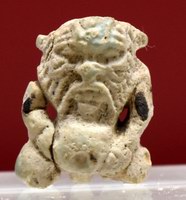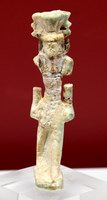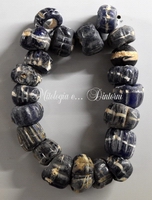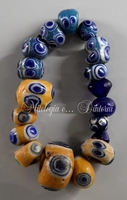Indice dei Musei
presenti in miti3000
Napoli Museo Nazionale - Piano -1 - Sala XXIII La scultura - SCULPTURE
- Intro sala XIX
- Sala XIX
- Intro sala XX
- Sala XX
- Intro sala XXI
- Sala XXI vetrina 49
- Sala XXI vetrina 50
- Sala XXI vetrina 51
- Sala XXI vetrina 52
- Sala XXI vetrina 53-54
- Sala XXI vetrine 55-56
- Sala XXI vetrine 57 - 58
- Sala XXI vetrine 60 - 61
- Sala XXI vetrine 62 - 63
- Intro Sala XXII
- Sala XXII vetrine 70 - 78
- Sala XXII vetrine 79 - 84
- Intro Sala XXIII
- Sala XXIII v.87-92
- Sala XXIII v.93-97
- Sala XXIII v.98-104
Testo
Sala XXIII
Le Vetrine da 93 a 97
Vetrina 93
La scultura - SCULPTURE
1 Frammento di statuetta femminile con lastra dorsale
Calcare, pigmento. XI dinastia (2055-1985a.C.)
Collezione Borgia, inv. 951
1 Fragment of a women statuette with back slab
Calcare, pigmento. 11 th dynasty (2055-1985 a.C.)
Collezione Borgia, inv. no. 951
2 Testa di sovrano incompiuta da officina di scultore
Calcare. Inizi Epoca Tolemaica (300-200a.C.)
Collezione Borgia, inv. 398
2 Unfinished head of a Ring from a sculptor's workshop
Limestone. Early Ptolemaic Period (300-200 BC)
Borgia collection, inv. no. 398
3 Testa modello regale da officina di scultore
Calcare. Epoca tolemaica (332-30 a.C.)
Collezione Borgia, inv. 880
3 Model king's head from a sculptor's workshop
Limestone. Ptolemaic period (664-332 BC)
Borgia collection, inv. no. 880
EDILIZIA - BUILDING
MESTIERI: muratore
Ti dico anche del muratore che costruisce muri: è dolorosa la frusta contro di lui, è sempre esposto al vento, e fabbrica muri in grembiule da lavoro; la sua cintura, sul lavoro, è di loto, per lasciare libero il suo didietro; le sue braccia sono rovinate dalla... e tutti i suoi vestiti sono macchiati. Mangia pane con le dita e si lava una volta l’anno; ed è del tutto miserabile; lavora in una stanza di dieci cubiti per sei è pagato nel mese successivo e quando ha messo gli stipiti, le soglie e gli infissi, e sono finiti tutti i lavori relativi; quanto al pane, lo dà alla sua famiglia; i suoi figli sono molto picchiati.
(Papiro Sallier II, 6, 1)
WORK: the mason
I will also tell you about the mason who builds walls. The lash is painful for him. He is always in the wind. He builds walls wearing a work apron. When at work, his girdle is of lotus leaf to leave his behind free. His arms are ruined by... and all his clothes are stained. He eats bread with his fingers and washes once a year. He is totally miserable. He works in a room measuring ten cubits by SIX. He get paid the following month, and after he has installed the jambs, the THRESHOLDS and beams, and done all the attendant work. As to his bread, he gives it to his family. His children get beaten a lot.
(Papiro Sallier II, 6, 1)
Amuleti - Amulets

1-5 filo a piombo, 6-13 squadra o livella - 1-5 plumb line amulet, 6-13 level amulet
Amuleti - Amulets

1-3 amuleti Uadj - papiro - 1-3 wadj - papyrus amulet
MUSICA
Coppia di suonatori
Faïence. XXVI dinastia (664-525 a. C.)
Collezione Borgia, inv. 764
MUSIC
Two flute-players
Faïence. 26th Dynasty (664 - 525 BC)
Borgia collection, inv no. 764
AGRICOLTURA
Statuetta funeraria con cestino e zappa per coltivare i campi.
Uscebti
Faïence con iscrizione sovraddipinta in nero.
Tardo Nuovo Regno
Collezione Borgia, inv. 924
AGRICULTURE
Funerary statuettes with basket and hoe to cultivate the fields.
Shabti
Faïence with inscription depicted in black.
Late New Kingdom
Borgia collection inv. no. 924
Uscebti
Faïence con iscrizione sovraddipinta in nero.
Tardo Nuovo Regno
Collezione Borgia, inv. 924
Shabti
Faïence with inscription depicted in black.
Late New Kingdom
Borgia collection, inv. no. 924
Sistro
Bronzo. Età augustea (I sec. a.C. - I d.C.)
Pompei, inv. 109669
Sistrum
Bronze. Augustan Age (1st cent. BC- I cent. AD)
Pompeii, inv. no. 109668)
Vetrina 94
Uscebti di Nesmin
Faïence, XXVI din. (664-525 a.C.)
Capua, Alveo Marotta (550-500 a.C.)
Shabti of Nesmin
Faïence 26th Dynasty (664-525 BC.)
Capua, Alveo Marotta (550-500 BC)
Bes
Faïence, Epoca Tarda (664-332 a.C)
Capua, tomba 1415
Bes
Faïence, Late Period (664-332 BC)
Capua, Tomb 1415
Horus falco
Faïence, XXII dinastia (945-715 a.C.)
Capua, tomba n. 200
Horus as a hawk
Faïence, 22nd Dynasty (945-715 BC)
Capua tomb 200
Nefertum
Faïence. XXII dinastia (945-715 a.C.)
Capua, tomba 697 loc. Fornaci
Nefertum
Faïence. 22nd Dynasty (945-715 BC)
Capua, tomba 697 loc. Fornaci
Sekhmet
Faïence. XXII dinastia (945-715 a.C.)
Capua, località Fornaci, tomba n. 697
Sekhmet
Faïence. 22nd Dynasty (945-715 BC)
Capua, Fornaci, tomb 697
Scarabeo iscritto
Pasta azzurra. 775-700 a.C.
Capua, tomba 200
Scarab with inscription
Blu paste. 775-700 a.C.
Capua, tomb 200.
Vetrina 95
Bacheca
Posiziona il mouse sulle immagini per avere più informazioni, Cliccaci sopra per l'ingrandimento.
Place the mouse on the images to get more information, click on it to enlarge.
 Vago - Necklace
Vago - Necklace
Tre vaghi a occhioni, Pastata vitrea. VIII -VII sec. a.C., Cuma. - Three necklace elements, Glass paste. 8th-7th cent. BC, Cuma. - Statuetta miniaturistica, Pasta vitrea. VIII-VII sec. a. C., Cuma. - Miniature statue, Glass paste. 8th-7th cent. BC, Cuma. - Scarabeo, Faïence, elettro. VIII sec. a.C., Cuma Inv. 126497. - Scarab, Faïence, electro. 8th cent. BC, Cuma, inv 126497. - Scarabei, Faïence, argento. VIII sec. a.C., Cuma Inv. 161596, 126470. - Scarabs, Faïence, silver. 8th cent. BC, Cuma Inv. 161596, 126470. - Scarabeo, Faïence, argento.VIII sec. a.C., Cuma Inv. 84428a,b. - Scarab, Faïence, silver. 8th cent. BC, Cuma Inv. 84428a,b.
Fusaiola biconica
Faïence bruna con smalto verde e nero, sec, VIII a.C.
Cuma, necropoli arcaica (scavo Stevens). Inv. 140755
Biconical “Fusaiola”
Brown Faïence with green and black glaze, cent. 8th B.C.
Cuma. archaic necropolis (Stevens’ excavations). Inv. 140755
Fusaiola biconica
Faïence con smalto verde e azzurro. sec- VIII a.C.
Cuma, nocropoli arcaica (scavo Stevens). Inv. 140857
Biconical “Fusaiola”
Faïence with green and blue glaze, cent. 8th BC.
Cuma, archaic necropolis (Stevens’ excavations), inv. 140857
Collana
Pasta vitrea. VIII sec. a.C
Cuma
Necklace
Glass paste. 8th cent. BC
Cuma
Collana
Pasta vitrea. VIII sec. a.C
Cuma
Necklace
Glass paste. 8th cent. BC
Cuma
Collana
Pasta vitrea. VIII sec. a.C
Cuma
Necklace
Glass paste. 8th cent. BC
Cuma
Scaraboide
Ambra. VIII sec. a.C.
Cuma, inv.12642
Scaraboid
Amber. 8th cent. BC
Cuma, inv. 12642
Vetrina 96
Scarabeo con castone e pendaglio
Faience. VIII sec. a.C. (725 - 700 B.C.)
Calatia
Scarab with bezel and pendant
Brown faience. 8th century B.C. (725 - 700 B.C.)
Calatia
2 Scarabeo
Faience verde. VIII sec. a.C. (725 - 700 B.C.)
Calatia
2 Scarab
Green faience. 8th cent. B.C. (725 - 700 a.C.)
Calatia
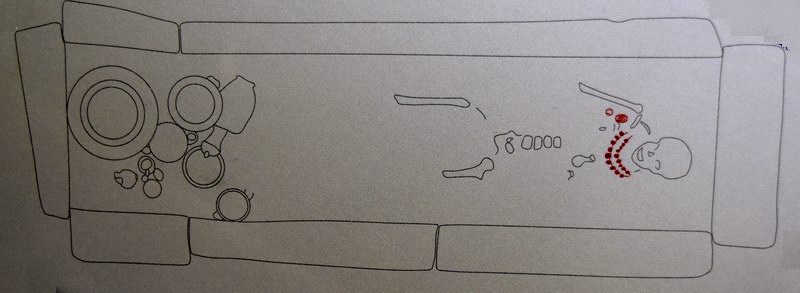
Esempio di tomba femminile dell'Orientalizzante con posizione degli scarabei sul corpo.
Example of a female tomb of the Orientalizing period with the position of scarabs on the body.
VETRINA 97
ISEO DI ERCOLANO
L’iseo di Ercolano, anche se non ancora individuato, si trovava molto probabilmente nella cosiddetta “Palestra”. Qui vennero infatti alla luce significativi oggetti di culto egiziano, fra cui la statua del dio Atum signore di Eliopoli, due statuette in bronzo di Iside Fortuna e Arpocrate, una bulla in oro, e una basetta decorata con pseudo-geroglifici.
BASE DA ERCOLANO
Rinvenuta il 13 settembre 1760 all’ingresso della c.d. Palestra, ha forma di tempietto su piccolo plinto, con pareti leggermente aggettanti sormontate da toro e cornice a gola. Le pareti sono decorate con geroglifici di fantasia incisi a bulino e con andamento speculare verso il centro. Non sappiamo cosa reggesse.
Isis from Herculaneum
Although no temple of Isis has been found at Herculaneum so far, it is very likely that there was one in the area of the so-called “Palaestra” (gymnasium). Significant Egyptian cultic objects came to light here, including a statue of Atum, lord of Heliopolis, a small bronze statue of Harpocrates, a golden “bulla”, two bronze statuettes showing Isis Fortuna and Harpocrates, and a small base decorated with pseudo-hieroglyphs.
Base from Herculaneum
This small bronze object came to light on 13 September 1760 in the entrance hall of the so-called “Palaestra” (gymnasium). It is shaped as a temple on a small plinth with slightly tapering sides surmounted by a torus molding. Its sides are graced with fantasy hieroglyphs. We do not know what stood on it originally.

Fotografie di Giorgio Manusakis









